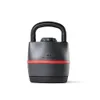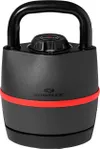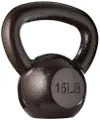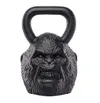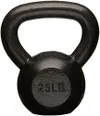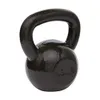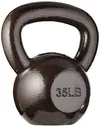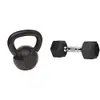I tried this 4-move kettlebell workout to build full-body strength — here's what happened to my body
You just need four kettlebell exercises

During the pandemic, many people turned to online workouts to help them stay in shape, and, frankly, avoid insanity. I found these sessions invaluable, but I didn’t stick with them when the world returned to what we consider normal, so when I was challenged to try an online workout, I was keen to dive back in.
You just need one or two of the best kettlebells to do it, and I've included the full video below for you to follow along. This 30-minute “kettlebell shred workout” was designed by Todd McCullough, former University of Florida linebacker and founder of TMAC Fitness. The focus is, as he puts it, “Getting the busy individual in great shape.”
Having done it a couple of times, I can state with certainty that it is, as McCullough says (with some pride), a killer workout. He also describes it as “fun,” but your mileage may vary on that. That said, it is hugely effective and I will return to it. Here’s why.
Watch the 30-minute kettlebell workout by Todd McCullough:
The four-move workout has four rounds and appeals for several reasons:
It’s short. McCullough is a big advocate of HIIT — for him, it’s “the most effective and fastest way to get the most results” — and you can see that in this session.
Secondly, it only takes 30 minutes with 20 or so of those spent on the core elements of the workout; the rest comprises a warm-up, some core work, stretching and what McCullough calls “mind-right meditation.”
It requires very little equipment: a mat and kettlebells, meaning you can do this at home. It’s also adaptable, so you can use a weight that suits you and go as slowly or as fast as you wish.
Sign up to get the BEST of Tom's Guide direct to your inbox.
Get instant access to breaking news, the hottest reviews, great deals and helpful tips.
Next reason? It’s a full-body workout — I felt it everywhere afterward. And then, there’s the final reason: no trainer around, so there’s less pressure.
McCullough begins with a five-minute warm-up, and I strongly advise doing it. He concentrates on loosening the lower back and opening up the hips — given what’s in store, this is wise. You’ll carry out the moves more efficiently and safely when your body is properly primed.
Here are the four moves and my thoughts.
1. Kettlebell swings
McCullough uses a 60lb bell for this one, which is way out of my league. I used a 35lb weight, which was just right. Be sure to have a firm grip on the bell, because if it slips from your hand, you can add home repairs to your workout (read: how to hold a kettlebell properly).
I’ve tried this move before, so I know not to aggressively arch my back or raise the bell too high. Follow McCullough’s lead and you’ll be fine.
2. Triceps push-ups
Place the kettlebell on an exercise mat (and be sure to use one if you have a hard floor surface), then adopt a high plank with your hands on the bell of the kettlebell; this positions your arms closer to your body, placing more emphasis on the triceps.
McCullough uses small, cast-iron bells (I think) but mine are larger and more cumbersome and I found it hard to keep my hands in position. However, you can just as easily employ the diamond push-up or close-grip push-up for this part of the workout, which is what I did.
3. Reverse lunges
I found this one fairly easy to do using a 16lb weight for the first two rounds, but by round three, I was swaying a little. By the final round, I wasn’t so much lunging as dipping. Don’t try to keep up with McCullough; go at your own pace to maintain form.
4. Transverse pulls
This one caused me serious problems because it requires a degree of coordination I don’t possess. Also, I had never done the move before. To be fair, McCullough acknowledges this requires “a lot of teaching,” so I didn’t feel too bad.
To do the move, place the kettlebell inside your left heel. Grab the bell with your right hand, raise it, then switch hands and lift the bell overhead as you pivot on your left foot. Switch sides.
I made a mess of this one for the first few reps… of every round. This was immensely frustrating, as McCullough makes it look easy. I got the hang of it but often felt as though I had been asked to rub my belly with one hand and pat my head with the other.
Don’t allow the bell to stray away from your body as you raise it above your head; lift high, straight and close to your body with the bell resting at the outer forearm. Then it's back to the beginning for round two.
Verdict
By the end of the session, I was sweating up a storm and breathing hard, but it felt good. McCullough then throws in a little core work (including Russian twists with the kettlebell of your choice) and finishes with a meditation.
This is where I part company with the workout, but it may be just what you need to set you up for the day. I know they work for a lot of people, but visualization techniques hold no appeal for me. I stayed present for the excellent workout, and that was more than enough for me.
I felt this routine in my glutes, triceps, and back muscles the day after. Now that I’m familiar with the cycle of moves, I feel I could do them without using the video.
That said, playing it in the background meant I didn’t have to count reps or look at a timer, which made things slightly easier. And I can always take a peek when I make a mess of the transverse pull. Which I will.
More from Tom's Guide
- I did 30 side planks with a lateral raise every day for a week — here's what happened
- No, not sit-ups — these are the two abs exercises you need to sculpt a six-pack, according to a personal trainer
- I walked 6,500 steps with Fitbit Inspire 3 vs. Samsung Galaxy Fit3 — here's the winner
John is a writer and editor based in London. He was worked for magazines such as Runner’s World, Men’s Health, Women’s Health and Cosmopolitan. A keen runner, what he lacks in ability he makes up for with enthusiasm and excuses.
You must confirm your public display name before commenting
Please logout and then login again, you will then be prompted to enter your display name.

